|
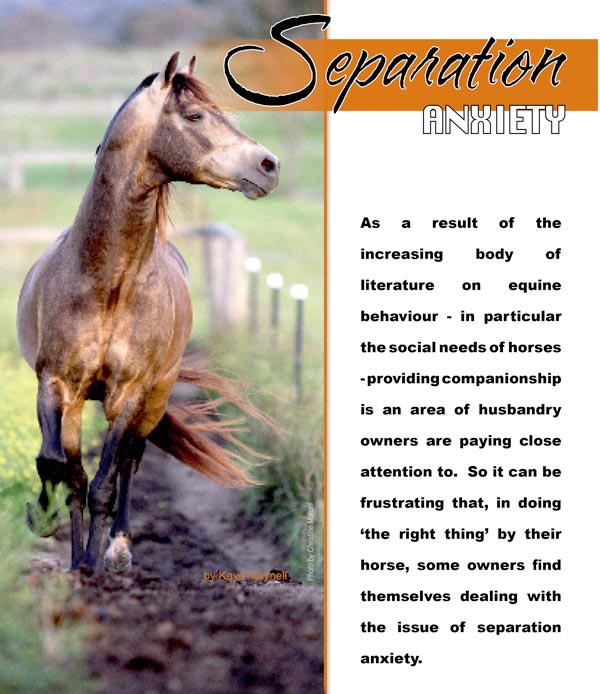
Separation anxiety in horses is not uncommon, especially in domestic horses that can spend significant periods of their life living with just one or two other horses. Many owners will recall having had a horse or pony that was reluctant to leave a buddy or, once separated, continued to call out constantly. Whilst it is true that some horses spend years living together, it is unlikely that this will remain the case for their entire life, and separation at some point is often unavoidable.
Many names are used for these horses that fret when asked to leave a companion or their usual surroundings, including “barn sour”, “herd bound” or sometimes just “neurotic”, and the affected horse may be the one being removed from the paddock or stable to another location - perhaps only a few short metres away- or the one being left behind.
Distress due to separation from the herd or a paddock-mate, is not only unpleasant for the horse but can be frightening and difficult for an owner to witness. Horses that run along fence lines, frantically pace around the stable, call out to mates, are distracted whilst in the arena or try and bolt back home whilst riding out, can pose a serious risk not just to themselves but also to their riders and handlers. On top of the injury worry is added frustration for the owner, as it becomes a major task just to remove the horse from the paddock to groom it, let alone go for a ride, which can result in the joy of horse ownership being dimmed.
WHY DO HORSES BECOME UPSET WHEN SEPARATED?
Behaviours such as these are more natural for a horse than one would initially think, especially since humans tend to view these performances from their own (uniquely human) perspective! It is crucial to remember that horses have evolved as prey animals, and belonging to a herd - and the strong social bonds associated with this equals safety - other horses serving as additional pairs of eyes that can be on the lookout for predators. For horses, leaving familiar buddies or places means leaving themselves vulnerable to attack; as such they are hard-wired to do everything within their power to avoid letting this happen.
“Some horses seem to make stronger attachments to other horses and have a difficult time dealing with separation from one or more herd mates,” explains Anne Gage of Confident Horsemanship, a professional coach, author and trainer of horses for over 25 years. “Whether this is caused by nature (genetic predisposition) or nurture (management) is up for debate.”
Weaning, isolation, being separated from the usual herd (or herd mate) and/or being reintroduced to a new group are all stressors for these highly social animals, and horses can exhaust themselves in their efforts to get back to an equine companion; pacing for hours or days, refusing to eat…often so anxious they are trembling, tense and sweaty.
“Once the stress begins, adrenaline is coursing through the horse’s blood stream and it becomes harder for it to settle itself; the physical activities exacerbate the emotional distress,” comments Anne.
In this situation, where the horse is in a state of stress frequently - or for a prolonged length of time - its natural defence systems are impaired and resistance to illness lowered as a result of the hormone cortisol.
Whilst cortisol is very useful in the initial stages of a stress response - because it increases the metabolism of glucose and thus provides the horse with more immediate energy to respond to danger - high levels of the hormone over time leads to problems such as reduced performance, lack of appetite and subsequent weight loss, slow recovery from illness, diarrhoea, respiratory and cardiac problems, and an animal generally lacking in vitality.
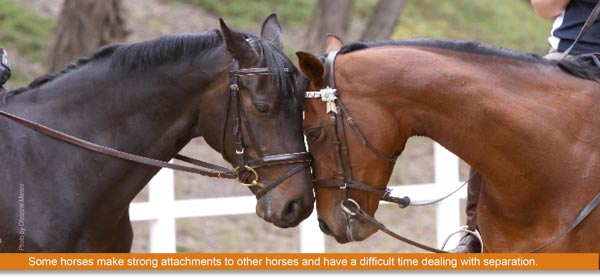
ADDRESSING THE ISSUE:
It is important that the first step for owners observing these behaviours is consulting a veterinarian to rule out any health issues or underlying causes of pain that may be the root of the behaviour. Only then can the process of training the horse to gradually become more confident in the absence of other horses begin.
“Prevention is always the best course of action,” says Anne. “Since the reality of life for most horses is that they will be moved from place to place and live with different horses – or even on their own – throughout their life time, it is best to prepare them when they are young. Systematically accustom them to the comings and goings of pasture mates for short periods and long periods; even changing turnout groups occasionally if possible.”
For the majority of owners, who have bought a mature horse, modifying the horse’s behaviour through sympathetic, consistent and patient training is the way forward in alleviating the apprehension and stress when separated from a favoured companion. It is critical, as with all training, that this is done gradually - always in a relaxed manner and in an environment in which the horse feels secure.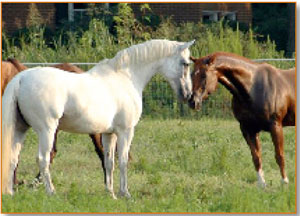
Being introduced to a new herd or paddock companion can be stressful for the horse.
For horses that begin to fret when another horse (or themselves) are led out of the paddock, there are several options to slowly get them accustomed to being separated, whilst all the time providing reassurance that they will not be left alone and vulnerable for the rest of their days! If there isn’t an adjacent paddock available to use, then an electric fence can be used to divide the paddock in half as an alternative. The horse with the issue can be moved into one half, and the other horse(s) with which it has formed an attachment, remains in the first. Initially, ensure that the first group of horses have a small paddock so they cannot wander off out of sight of the anxious horse. This should be done only for a couple of minutes initially, and then the horses are reunited in the same area once again. Gradually, the length of time spent separated can be increased until the horse is content with being able to see and touch the other horse(s) over the fence. Generally, as time progresses, the anxious horse will find the confidence to move further away from the fence line, as it realises the other horses aren’t going anywhere. Giving a small feed during the initial stages of separation can help by making it a positive experience and providing some distraction.
In a situation where splitting the paddock with electric fencing isn’t feasible, and there isn’t another paddock nearby, another option is simply removing the horse from the paddock or yard (either the anxious horse itself, or the paddock mate if the anxious horse struggles with being left behind), at first always in sight of the other horse, and gradually increasing the distance and amount of time spent away.
USEFUL TIPS
Anne provided some useful tips for the owner of a gelding that had become very attached to one of two mares in its paddock. “Start by simply taking the mare out of the paddock for a short time, but keeping her close enough that the gelding does not get stressed. If he gets stressed as soon as the mare is taken out of the gate, simply stay near the fence line – even letting them touch noses over the fence. Once the gelding settles, walk the mare a bit further away. When he gets stressed, bring her back. As he settles, continue extending the distance between them. You can help the gelding deal with the situation even more if you have someone who can assist by taking the mare out of the paddock; the second person can then handle the gelding. Have him on a long lead rope or a lunge line. Gently ask him to bring his head down before the mare is taken out of the paddock - with his head at wither height or lower, your horse is in a ‘calm’ posture rather than in ‘flight’ mode.
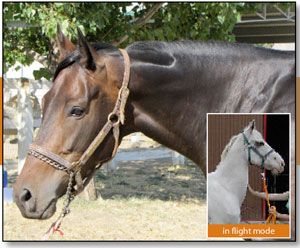
Asking the horse to bring its head down at wither height or lower, puts it in a ‘calm’ posture rather than in ‘flight’ mode. Changing its physical posture also affects the horse’s mental state.
Changing his physical posture also affects his mental state. When he gets stressed, he may not be able to stay in this posture and will want to move. Allow him to move, but control where he is going by keeping contact on the lead rope and asking him to turn a very small circle around you. In this way, you are addressing his very real need to move and allowing him to process the physical and mental stress he is feeling. Be sure that he does not bend into you while you do this -keep enough contact on the rope to keep his nose lined up with the centre of his chest or tipped slightly towards you and swing the end of your lead rope behind you and towards his girth (about his elbow height). You can also use a dressage length whip to tap this area. This exercise is also asking him to keep his focus on you rather than on the mare. The point of this exercise is to show him that he can feel calm even when the mare is not with him.”
The same technique can also be applied to horses in the stable complex that get stressed when led outside, or when left behind if another horse leaves. Either horse can be taken outside for gradually increasing lengths of time before being returned to the stable, until the anxious horse is happy to be left in its stable (or taken outside) for several hours. This is not to say that a horse should be left alone in a stable with no other companions – where possible ensure other equines are in the stable complex – just not the bonded pair. If this isn’t achievable (e.g. there are only two horses on the property) other stable companions can be provided such as goats or chickens, depending upon the temperament of the horse and the space available. Again, food can be a good sweetener during the initial times of separation – as the time spent apart increases, toys or haynets that allow for trickle feeding can be used to occupy more of the horse’s time - which will prevent stress and discourage stereotypies such as box walking.
It is important to allow horses the time they need to get accustomed to being away from friends, and to build their confidence gradually; though it may not be something that can be ‘fixed’ quickly, with patience and considerate handling the situation can be improved for both horse and owner.
It might also be wise to remember the old saying ‘horses for courses’, as though owning a horse with separation anxiety may seem a disadvantage, for some it works out just fine and with a few small tweaks to the daily routine here and there, can actually be as fulfilling as owning any other ho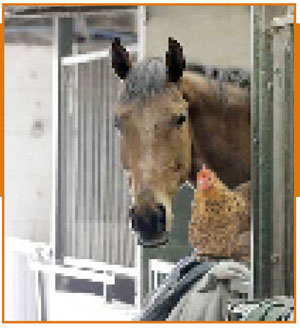 rse. rse.
If another horse as a companion isn’t achievable other stable companions can be provided, such as goats or chickens, depending upon the temperament of the horse and the space available.
MANAGING ANXIETY
Just how much a horse reacts to being separated from a buddy or the herd, or being asked to leave familiar surroundings, is a result of a range of factors including individual temperament, training, and past experiences involving isolation or separation from other horses. Though at times incredibly frustrating and stressful, owners should try to remember that their horse is not simply having a temper tantrum, but is in a very real state of anxiety that has a physiological as well as psychological impact on its wellbeing.
Punishment should never be inflicted upon the horse when things aren’t going as expected and it is perhaps becoming stressed and/or bolshy – this will only serve to reinforce to the horse that it should be frightened by the situation and what is being asked of it. Looking at how the behaviour could be put to work in the horse’s favour shouldn’t be disregarded - there are instances where the desire to be close to other horses can be of benefit or at the very least manageable (e.g. in a riding school situation where several horses are asked to work in the same space together regularly). Creating a management plan that sets specific goals will help owners stay on track when it comes to helping their horse overcome the fear and apprehension of separation, and will allow them to recognise when a target has been hit…no matter how small the achievement.
These pre-established milestones can help prevent owners from feeling overwhelmed by what can feel an incredibly daunting task, by breaking down the process into bite-sized pieces which can be tackled a day at a time. Patience and consistency are key, and every ‘training’ session must be positive in order for the horse to trust that it is safe to leave his comfort zone, and that ultimately he will always be returned to safely to his buddy.
|